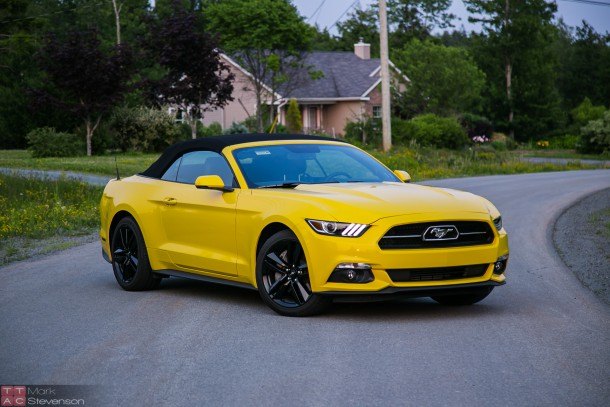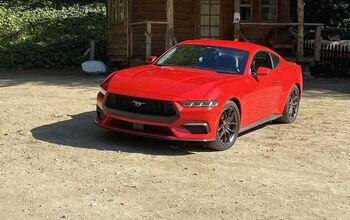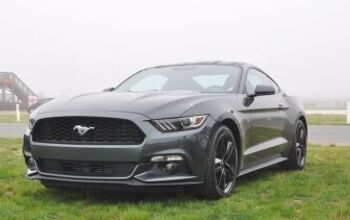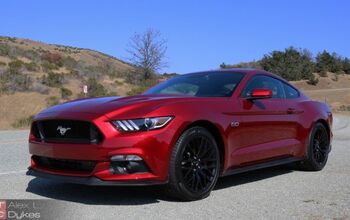2015 Ford Mustang EcoBoost Convertible Review - No Respect

I pull up next to a previous-generation Mustang — its 5-liter V8 rumbling as it sits at a stop light — and look over to the driver. There is no acknowledgement from him that I exist. Not a nod, glance, nor a typical, Mustang-owner two-finger wave.
That’s not surprising though — he probably couldn’t hear me.
The 2.3-liter EcoBoost inline four is but a whimper next to the eight cylinders of Detroit aluminum. I give the boosted four banger a slight tip of accelerator. Still nothing from the owner of the “five-point-oh.”
The Tester
2015 Ford Mustang Convertible EcoBoost Premium (Automatic)
Engine: 2.3-liter DOHC I-4, direct injection, twin independent variable camshaft timing (310 horsepower @ 5,500 rpm, 320 lbs-ft @ 2,500-4,500 rpm)
Fuel Economy (Rating, MPG): 20 city/30 highway/24 combined
Options: 201A Equipment Group (Shaker Pro Audio System, Memory Driver’s Seat and Mirrors, Blind Spot Information System with cross-traffic alert), Triple Yellow paint, 50 Years Appearance Package, EcoBoost Performance Package, Enhanced Security Package Active Anti, Theft System with Perimeter Alarm, HID Headlamps with Signature Lighting, Reverse Sensing System, Spoiler Delete, Wheel Locking Kit, 3.55 Limited-Slip Rear Axle, 19-inch-by-9-inch Gloss Black Premium Painted Aluminum Wheels, Raven Black interior, Adaptive Cruise Control with Collision Mitigation and Rain Sensing Wipers, SYNC with MyFord Touch, VoiceActivated Navigation System, Premium AM/FM Stereo with HD Radio.
As Tested (U.S.): $45,060 ( sheet)
It isn’t until the light turns green that my newfound nemesis in the neighboring lane graces me with a single eyeball. Even with the EcoBoost’s bright yellow paint, a pass is required to command the 5-liter’s driver to look to his right and gaze upon my taillights.
Admittedly, this is a very specific scenario. During normal driving, when other Mustang owners are traveling in the opposite direction, any Mustang — no matter the vintage — is still due its two finger, steering-wheel salute. Unless you’re driving a Mustang II.
Exterior
The headlights give the Mustang a purposeful, angry demeanor, while the long hood foretells of engines upwards of eight cylinders, though that hood is a bit of a lie in this case.
On our convertible tester, the looks are greatly improved as soon as you drop the top. There is no cover for the folded roof, but it is neatly packed away behind the rear seats — unlike the Beetle Convertible — and doesn’t really require a covering. The belt line is rather high, but it works in this case. The Mustang is a big-bodied pony car and it should have as much sheet metal as is possible.
The convertible, I’d argue, has a better silhouette than the new coupe. Instead of the awkward rear-window profile, the convertible offers a flatter and seemingly longer, deck lid. Our tester, with the EcoBoost Performance Package and 50 Years Appearance Package had its rear spoiler deleted, which made for one of the cleanest looking forms of the Mustang money can buy.
My only qualms with the Mustang’s design have to do with the rear. The designers at Ford had an opportunity to go all new with their latest creation, but the rear is still stuck in the past.
Interior
Below the large MyFord Touch screen and HVAC controls sits a row of toggle switches to change driving mode, steering effort and a few other options. I would prefer these be closer to the driver and out of reach of any underage passengers trying to be clever by flipping between Comfort and Sport steering modes mid-corner.
Another pet peeve: Ford has decided to put the boost gauge right in the middle of the dash, far outside the peripheral vision of the driver. Please, Ford, put this in the instrument panel. At the very least, this could be one of the performance gauges offered up by the digital display between the speedometer and tachometer.
The seats are, well, just fair. I found myself constantly readjusting in order to be comfortable. Also, thanks to the speedometer and tachometer being fairly far apart from each other, the view through the steering wheel to the gauges can be compromised by the steering wheel itself.
The phrase “backseat comfort” in a car like this is an oxymoron, so I’m not even going to mention it.
Infotainment
SYNC’s voice-activation feature is one of the best systems for people like me who have horrible regional accents. Somehow, whether it be the folks at Ford or Microsoft (the company responsible for the software guts of SYNC) the system is able to figure out how to cut through all my weird ‘ar‘ combinations and other oddball dialectical artifacts.
Beyond that, the optional Shaker audio system might sound great in the coupe, but in the Mustang convertible it sounds like a tinny mess. If you can avoid the extra cost, do so.
Drivetrain
Ford’s new found love for turbocharging, combined with its “One Ford” plan to send Mustangs to Europe, has resulted in a four-cylinder Mustang with a twin-scroll turbocharger hanging off its side. On top of that, this engine is considered to be a premium choice over the 3.7-liter V6 engine.
Sitting them side by side, the EcoBoost four does, in fact, make more horsepower and torque. However, the quality of how it delivers that power and its attack on your senses is not something I would call premium.
For starters, the EcoBoost engine — even with faux exhaust note pumped through the Shaker audio system — sounds like any other four-cylinder engine on the market. Neither the engine nor exhaust notes are pleasing to the ear. Remember back when Hondas and Acuras would activate all the VTEC goodness at the top RPMs? Remember how great that sounded? The exact opposite is happening here.
That’s not to say the EcoBoost mill is a horrible engine. If your plan is to putt around town and stay out of the boost, the little four pot will return some pretty excellent fuel economy, even with the six-speed automatic. But, if you are looking for an experience pleasing to the ear, get a 6- or 8-cylinder engine.
Drive
For starters, the Mustang still sports a stiff ride, even with its new-fangled independent rear suspension. Handling might be improved, but the convertible still communicates a fair amount of chassis flex. With the top up, the Mustang isn’t even close to quiet; in truth, it even seemed quieter with the top down. It’s still a Mustang, foibles and all.
If the V6, automatic, convertible Mustang is the Cheerleader Edition of the Ford’s pony car, this EcoBoost-powered version is for the cheerleader that munches on Adderall from a Pez dispenser. It’s high-strung when pushed, but relaxed when it needs to be. The only time it sounds good is when you can’t hear it. And, to top it all off, this car is nearly $50,000. That’s fifty grand for a four cylinder.
Get the six. Save your money. Invest in the improved auditory experience for yourself and others. Turbocharging is not the answer — at least in this case.

More by Mark Stevenson
Latest Car Reviews
Read moreLatest Product Reviews
Read moreRecent Comments
- Jeff Overall I prefer the 59 GM cars to the 58s because of less chrome but I have a new appreciation of the 58 Cadillac Eldorados after reading this series. I use to not like the 58 Eldorados but I now don't mind them. Overall I prefer the 55-57s GMs over most of the 58-60s GMs. For the most part I like the 61 GMs. Chryslers I like the 57 and 58s. Fords I liked the 55 thru 57s but the 58s and 59s not as much with the exception of Mercury which I for the most part like all those. As the 60s progressed the tail fins started to go away and the amount of chrome was reduced. More understated.
- Theflyersfan Nissan could have the best auto lineup of any carmaker (they don't), but until they improve one major issue, the best cars out there won't matter. That is the dealership experience. Year after year in multiple customer service surveys from groups like JD Power and CR, Nissan frequency scrapes the bottom. Personally, I really like the never seen new Z, but after having several truly awful Nissan dealer experiences, my shadow will never darken a Nissan showroom. I'm painting with broad strokes here, but maybe it is so ingrained in their culture to try to take advantage of people who might not be savvy enough in the buying experience that they by default treat everyone like idiots and saps. All of this has to be frustrating to Nissan HQ as they are improving their lineup but their dealers drag them down.
- SPPPP I am actually a pretty big Alfa fan ... and that is why I hate this car.
- SCE to AUX They're spending billions on this venture, so I hope so.Investing during a lull in the EV market seems like a smart move - "buy low, sell high" and all that.Key for Honda will be achieving high efficiency in its EVs, something not everybody can do.
- ChristianWimmer It might be overpriced for most, but probably not for the affluent city-dwellers who these are targeted at - we have tons of them in Munich where I live so I “get it”. I just think these look so terribly cheap and weird from a design POV.












































Comments
Join the conversation
Where is the 2015 Mustang GT review on TTAC? I can't seem to find it.
This Mustang roadster is undoubtedly a snazzy looking beast. The interior styling is also classy. Hopefully, it also handles the draft well at high speeds. Well, for my kind of countryside weather, an additional wind deflector like a Windblox windblocker may be required to rein in the turbulence.